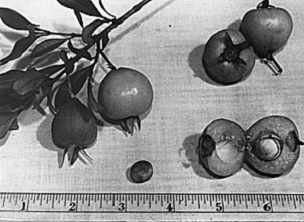From the book
Fruits of Warm Climates
by Julia F. Morton
Pitomba
Eugenia
luschnathiana
Klotzsch ex O. Berg.
Phyllocalyx luschnathianus Berg.
MYRTACEAE
The pitomba, Eugenia
luschnathiana Klotzsch ex O. Berg. (syn. Phyllocalyx luschnathianus
Berg.) is also called uvalha do campo, ubaid do campo, or uvalheira in
Brazil.
It
is an attractive, slow-growing tree to 20 or 30 ft (6-9 m) high, with
dense foliage. The evergreen, opposite, short-petioled,
oblong-lanceolate leaves, 1 to 3 in (2.5-7.5 cm) long, are glossy,
dark-green on the upper surface, paler beneath. New growth is
temporarily coated with bronze hairs on the underside. The
long-stalked, 4-petalled, white flowers are borne singly in the leaf
axils.

Fig.
106: Little-known, the orange-yellow pitomba
(Eugenia luschnathiana) is
of fair size and thick-fleshed
when well-irrigated and fertilized.
The fruit, broad-obovate, faintly 4-lobed, 1 to 1 1/4 in
(2.5-3.2 cm) long, is bright orange-yellow with 4 or 5 green sepals 1/2
in (1.25 cm) long protruding from the apex. The skin is thin, tender,
and the pulp golden-yellow, apricot-like in texture, soft, melting,
juicy, aromatic and slightly acid, faintly resinous in flavor. In the
central cavity there may be one round seed or 2 to 4 irregular, angular
seeds, light-tan and 3/8 to 5/8 in (1-1.6 cm) in diameter.
This
little-known species is native to the State of Bahia, Brazil, is
cultivated to a limited extent locally and is grown in the botanical
garden in Rio de Janeiro. Seeds were brought to the United States from
Brazil by plant explorers for the federal Department of Agriculture in
1914 (S.P.I. #37017). A very few specimens, scarcely more than shrubs,
have been grown to the fruiting stage in southern Florida. The pitomba
was at first considered promising for this area but has made no
progress at all in the last 40 years.
When in good soil,
well-fertilized and frequently and heavily watered, the tree begins to
bear when less than 3 1/2 ft (a little over 1 m) high. There is much
variation in the size of fruits produced by seedlings. Sturrock made
some selections and grafted them successfully. Flowers appear in late
spring and early summer in Florida and the fruiting season is in
midsummer. In Brazil the fruits ripen in November and December. The
fruits are there used mainly for jelly, preserves, and carbonated
beverages.
|
|